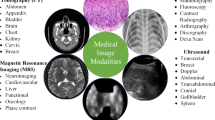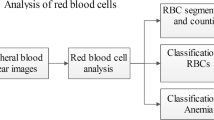Abstract
Blood analysis is regarded as the one of the most predominant examinations in medicine field to obtain patient physiological state. A significant process in the classification of white blood cells (WBC) is blood sample analysis. An automatic system that is potential of identifying WBC aids the physicians in early disease diagnosis. In contrast to previous methods, thus resulting in trade-off among computational time (CT) and performance efficiency, an interpolative Leishman-stained multi-directional transformation invariant deep classification (LSM-TIDC) for WBC is presented. LSM-TIDC method discovers possibilities of interpolation and Leishman-stained function, because they require no explicit segmentation, and yet they eliminated false regions for several input images. Next, with the preprocessed images, optimal and relevant features are extracted by applying multi-directional feature extraction. To identify and classify blood cells, a system is developed via the implementation of transformation invariant model for extraction of nucleus and subsequently performs classification through convolutional and pooling characteristics. The proposed method is evaluated by extensive experiments on benchmark database like blood cell images from Kaggle. Experimental results confirm that LSM-TIDC method significantly captures optimal and relevant features and improves the classification accuracy without compromising CT and computational overhead.







Similar content being viewed by others
Data availability
Data set used in this work is from https://www.kaggle.com/paultimothymooney/blood-cells and is licensed under MIT license.
References
Choi JW, Ku Y, Yoo BW, Kim JA, Lee DS, Chai YJ, Kong HJ, Kim HC (2017) White blood cell differential count of maturation stages in bone marrow smear using dual-stage convolutional neural networks. PLoS ONE. https://doi.org/10.1371/journal.pone.0189259
Fatichah C, Tange ML, Yan F, Betancourt JP, Rahmat Widyanto M, Dong F, Hirota K (2015) Fuzzy feature representation for white blood cell differential counting in acute leukemia diagnosis. Int J Control Autom Syst 13:742–752
Ghosha P, Bhattacharjeeb D, Nasipuriba M (2019) Blood smear analyzer for white blood cell counting: a hybrid microscopic image analyzing technique. Appl Soft Comput 46:629–638
Hegde RB, Prasad K, Hebbar H, Sandhya I (2018) Peripheral blood smear analysis using image processing approach for diagnostic purposes: a review. Bio Cybern Bio Med Eng 38:467–480
Liang G, Hong H, Xie W, Zheng L (2018) Combining convolutional neural network with recursive neural network for blood cell image classification. IEEE Transl Content Min 6:36188–36197
Livieris IE, Pintelas E, Kanavos A, Pintelas P (2018) Identification of blood cell subtypes from images using an improved SSL algorithm. J Sci Tech Res 9:6923–6929
Loffler H, Rastetter J, Haferlach T (2005) Atlas of clinical hematology, 6th edn. Springer, Berlin
López-Puigdollers D, Traver VJ, Pla F (2019) Recognizing white blood cells with local image descriptors. Expert Syst Appl 115:695–708
Nassar M, Doan M, Filby A, Wolkenhauer O, Fogg DK, Piasecka J, Thornton CA, Carpenter AE, Summers HD, Rees P, Hennig H (2019) Label-free identification of white blood cells using machine learning. Cytometry 95:836–842
Nazlibilek S, Karacor D, Ercan T, Sazli MH, Kalender O, Ege Y (2014) Automatic segmentation, counting, size determination and classification of white blood cells. Measurement 55:58–65
Othman MZ, Mohammed TS, Ali AB (2017) Neural network classification of white blood cell using microscopic images. Int J Adv Comput Sci Appl 8(5):99–104
Prinyakupt J, Pluempitiwiriyawej C (2015) Segmentation of white blood cells and comparison of cell morphology by linear and Naïve Bayes classifiers. Bio Med Eng 14:63
Rawat J, Annapurna Singh HS, Bhadauria JV, Devgun JS (2017) Leukocyte classification using adaptive neuro-fuzzy inference system in microscopic blood images. Arab J Sci Eng 8:1–18
Rodríguez Barrero CM, Gabalan R, Alberto L, Roa Guerrero EE (2018) A novel approach for objective assessment of white blood cells using computational vision algorithms. Adv Hematol 2018:4716370
Roopa B, Hegde Q, Prasad K, Hebbar H, Singh BMK (2019) Comparison of traditional image processing and deep learning approaches for classification of white blood cells in peripheral blood smear images. Bio Cybern Bio Med Eng 39:382–392
Safuan SNM, Tomari MM, Zakaria WN (2018) White blood cell counting analysis in blood smear images using various color segmentation methods. Measurement 116:543–555
Sajjad M, Khan S, Jan Z, Muhammad K, Moon H, Kwak JT, Rho S, Baik SW, Mehmood I (2016) Leukocytes classification and segmentation in microscopic blood smear: a resource-aware healthcare service in smart cities. IEEE Transl Content Min 5:3475–3489
Shahin AI, Guo Y, Amin KM, Sharawi AA (2019) White blood cells identification system based on convolutional deep neural learning networks. Comput Methods Progr Biomed 168:69–80
Sosnin DYu, Onyanova LS, Kubarev OG, Kozonogova EV (2018) Evaluation of efficacy of white blood cell identification in peripheral blood by automated scanning of stained blood smear images with variable magnification. Biomed Eng 52(1):31–36
Su M-C, Cheng C-Y, Wang P-C (2014) A neural-network-based approach to white blood cell classification. Sci World J 2014:796371
Them H, Diem H, Haferlach T (2004) Color atlas of hematology, practical microscopic and clinical diagnosis, 2, 2nd revised edn. Thieme, New York
Wang Y, Cao Y (2019) Quick leukocyte nucleus segmentation in leukocyte counting. Comput Math Methods Med 2019:3072498
Author information
Authors and Affiliations
Corresponding author
Ethics declarations
Conflict of interest
All authors state that there is no conflict of interest.
Additional information
Communicated by V. Loia.
Publisher's Note
Springer Nature remains neutral with regard to jurisdictional claims in published maps and institutional affiliations.
Rights and permissions
About this article
Cite this article
Karthikeyan, M.P., Venkatesan, R. Interpolative Leishman-Stained transformation invariant deep pattern classification for white blood cells. Soft Comput 24, 12215–12225 (2020). https://doi.org/10.1007/s00500-019-04662-4
Published:
Issue Date:
DOI: https://doi.org/10.1007/s00500-019-04662-4




